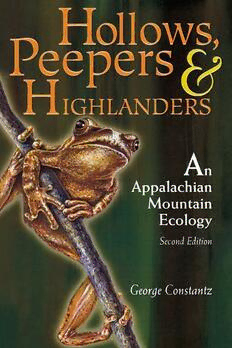
Hollows, Peepers and Highlanders: An Appalachian Mountain Ecology PDF
Preview Hollows, Peepers and Highlanders: An Appalachian Mountain Ecology
Hollows, Peepers, and Highlanders Hollows, Peepers, and Highlanders An Appalachian Mountain Ecology by George Constantz Second Edition West Virginia University Press Morgantown 2004 © 2004 by West Virginia University Press All rights reserved 14 13 12 11 10 09 08 2 3 4 5 6 7 8 ISBN (paperback) 0-937058-86-6 (alk. paper) Library of Congress Cataloguing-in-Publication Data Constantz, George. 1947– Hollows, peepers, and highlanders : an Appalachian Mountain ecology / by George Constantz Second edition. p. cm. — Includes illustrations and index ISBN 0-937058-86-6 1. Natural history— Appalachian Region. 2. Forest animals— Adaptation— Appalachian Region. 3. Forest plants— Adaptation— Appalachian Region. 4. Forest ecology— Appalachian Region. 5. Appalachian Region. I. Title. II. Constantz, George. IN PROCESS Library of Congress Control Number: 2003116400 Design by Lisa Bridges Design Printed by Bookmasters, Inc. Printed in U.S.A. Contents Thanks ………………………………………………… vii 1. Prologue ……………………………………………… 1 Stage and Theater 2. Origins ………………………………………………… 7 3. Forest Design ………………………………………… 17 4. Creating Diversity …………………………………… 25 5. Catastrophe and the Appalachian Quilt ……………… 33 6. Balds …………………………………………………… 41 7. The Asian Connection ……………………………… 45 The Players 8. The Improbable Lady’s-slipper ………………………… 51 9. Sexual Decisions of Jack-in-the-Pulpit ……………… 59 10. Nuptial Gift of the Hangingfly ……………………… 67 11. Femmes Fatales of Twilight ………………………… 73 12. Small Fishes in Shallow Headwaters ………………… 81 13. Darter Daddies ……………………………………… 89 14. To the Brook Trout, with Esteem …………………… 95 15. A Lungless Salamander Trilogy: Primer ………… 101 16. A Lungless Salamander Trilogy: Coexistence …… 109 17. A Lungless Salamander Trilogy: Mimicry ………… 115 18. Love Among the Frogs …………………………… 119 19. Box Turtle’s Independence ………………………… 127 20. Copperhead’s Year ………………………………… 133 21. Oaks and Squirrels ………………………………… 143 22. Highlanders ……………………………………… 151 Seasonal Acts 23. Autumn Leaves …………………………………… 165 24. Window on Bird Politics ………………………… 171 v 25. Thwarting Swords of Ice ………………………… 179 26. Spring Tensions …………………………………… 189 27. Dawn Chorus ……………………………………… 195 28. Trees and Caterpillars ……………………………… 205 Epilogue 29. The Remnant Archipelago ……………………… 217 30. Abuse, Resurrection, Hope ……………………… 229 Actors ………………………………………………… 242 Jargon ………………………………………………… 252 Sources ………………………………………………… 279 Index …………………………………………………… 343 Author ………………………………………………… 361 vi Thanks I owe a great deal to many generous people. John Ailes, Maurice Donohue, Marshall Sprague, and David Vis encouraged me to make the commitment. The following highlanders provided liter- ature: Jerry Atkins, Russell LaFollette, Gerald Lewis, Harold Parsons, Andy Rogers, Bob Smith, Gary Strawn, Charlie Streisel, Roger Thomas, Dr. Randy Thornhill, Ro Wauer, and Dr. Peter White. Dr. Quinn Constantz and Gary Wilson helped with the field work. For word processing help, I thank Tammy Barnes, Mary Kay Clem, Carol Fultz, Beth and Betty Loy, Jo Ann Shepherd, Jane Small, Bill and Dan Snyder, and Robby Pyles. Several chapters were critically re- viewed by Dr. George Bunting, Mike Clark, Rick Eades, Phil Gallery, Bob Groves, Mode Johnson, Jim Matheson, Philip Nixon, Ron Preston, Jim Rawson, Gian Rocco, Tom Stump, Dave Trimmier, and Paula Worden. The following people read and criticized the entire manuscript: Sylvia Donohue, Dr. Ed Flaccus, Dr. Bronson Griscom, Eric Patterson, Dr. Gary Evans, Kat Ort, Danny Williams, and sev- eral classes of biology students. Although their contributions do not fit neatly into a single category, I appreciate the help of the follow- ing mountaineers: Rodney Bartgis, Fred Carter, Grey Cassell, Dr. Patrick Conner, Kathy Emerson, Bob Faulkner, Ashley Judd, Dr. Ross Kiester, Gary Morfoot, Shirley Parsons, Arlene Saville, Charlie See, Phyllis Starkey, Harold Smallwood, John Rimel, and Linda Ullery. Two anonymous reviewers provided good ideas for this second edi- tion. My wife, Nancy Ailes, helped me every step of the way. Thanks to all. George Constantz May 1, 2004 vii 1 Prologue Iam an unabashed partisan of the Appalachian Mountains. It is not that there are rocky, majestic peaks here; quite the contrary: Eons of erosion have delivered rounded highlands that are ap- proachable and gentle on the eye. But beneath Appalachia’s soft exterior run myriad short-lived scenes, each being played out by an individual organism competing for its part in the evolutionary play. No play runs in a vacuum, though. As G. Evelyn Hutchinson, the intellectual grandfather of many contemporary ecologists, put it, the long-term evolutionary drama can only be appreciated within the context of its environmental theater. The play is complex, showcasing a tremendous diversity of ac- tors. Appalachia hosts more species of deciduous trees, salamanders, darters, and shrews than any other region of North America. Mosses, ferns, sedges, and heaths also abound. This huge variety of living things is due in large part to the highlands’ antiquity and convoluted topography. Appalachia’s beauty is dynamic, though, and every walk unique. Autumn colors, wing prints in snow, spring wildflowers, and a stream of tiger swallowtails punctuate my year. If you are open to it, every day will reveal a new sight, sound, or smell. Even in the dead of winter I can detect change in the tufted titmouse’s call, a shifting to the serious song of spring. I have written this book for three reasons. First, I want to share my excitement for viewing Appalachian plants and animals from an evolutionary perspective. Contemplating a leaf or laughing at a squirrel, friends often ask me, “What good is it?” or “Why does it 1
